
A Eurogame, also called a German-style board game, German game, or Euro-style game, is a class of tabletop games that generally has complex rules, indirect player interaction, and multiple ways to score points. Eurogames are sometimes contrasted with American-style board games, which generally involve more luck, conflict, and drama. They are usually less abstract than chess or Go, but more abstract than wargames. Likewise, they generally require more thought and planning than party games such as Pictionary or Trivial Pursuit.

500 or Five Hundred is a trick-taking game developed in the United States from Euchre. Euchre was extended to a 10 card game with bidding and a Misère contract similar to Russian Preference, producing a cutthroat three-player game like Preference and a four-player game played in partnerships like Whist which is the most popular modern form, although with special packs it can be played by up to six players.

Reiner Knizia is a prolific German-style board game designer. He was born in West Germany in 1957 and earned a doctorate in Mathematics from the University of Ulm before designing games full time. He is frequently included on lists of the greatest game designers of all time. Many of his hundreds of designs are considered modern classics, and many have won or been nominated for significant gaming awards, including the Spiel des Jahres and the Deutscher Spiele Preis. His notable designs include Amun-Re, Blue Moon City, Ingenious, Keltis, Lord of the Rings, Medici, Modern Art, Ra, Taj Mahal, Tigris and Euphrates, and Through the Desert. Many of his designs incorporate mathematical principles, such as his repeated use of auction mechanics.

El Grande is a German-style board game for 2-5 players, designed by Wolfgang Kramer and Richard Ulrich, and published in 1995 by Hans im Glück in German, by Rio Grande Games in English, and by 999 Games in Dutch. The game board represents renaissance-era Spain where the nobility fight for control of the nine regions. El Grande was praised for its area-control mechanism, and was awarded the Spiel des Jahres prize and the Deutscher Spiele Preis in 1996. Following its release, several expansions and an alternative version were published.
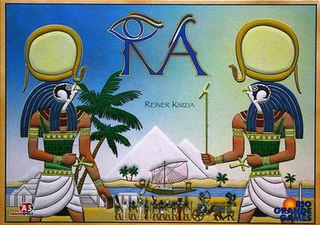
Ra is a board game for two to five players designed by Reiner Knizia and themed around Ra, the sun-god of Heliopolis in ancient Egyptian culture. It is one of three auction games designed by Knizia, the others being Medici and Modern Art.
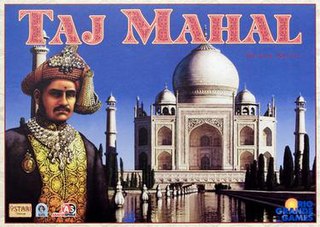
Taj Mahal is a German-style board game for 3–5 players designed by Reiner Knizia and first published in 2000 by Alea in German.
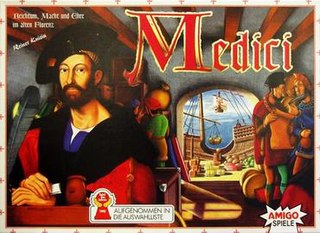
Medici is a German-style board game by Reiner Knizia. Players buy cards in an auction and match in series and in sets to end up with most points from those formations.
Blue Moon is a German collectible card game (CCG) designed by Reiner Knizia and published by Kosmos and Fantasy Flight Games in 2004.
6 nimmt! / Take 6! is a card game for 2–10 players designed by Wolfgang Kramer in 1994 and published by Amigo Spiele. The French version is distributed by Gigamic. This game received the Deutscher Spiele Preis award in 1994.

FITS (Fill In The Spaces) is a Tetris-like board game published by Ravensburger in 2009.

Blue Moon City is a 2006 designer board game by Reiner Knizia. The game has similar artwork to, and some thematic connections with, the Blue Moon card game, also designed by Knizia. It is a city-building game with a heavy fantasy theme.
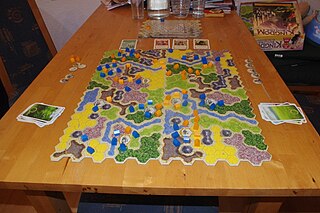
Kingdom Builder is a strategy board game designed by Donald X. Vaccarino, published in 2011 by Queen Games with illustrations by Oliver Schlemmer in German, British and international versions.

Las Vegas is a board game designed by Rüdiger Dorn and published by Ravensburger in 2012. It is named after the city of Las Vegas in Nevada, United States and has a gambling theme. The game was also nominated for the Spiel des Jahres prize in 2012.

Arno Steinwender is an Austrian board game designer and teacher. In his free time he develops board games, for which he has won several awards.

Bavarian Tarock or, often, just Tarock, is a card game that was once popular in Bavaria and also played in parts of Austria as well as Berlin. The name is a clue to its origin in the historical German game of [Gross-]Tarock, a game using traditional Tarot cards. At some point in the mid- to late-18th century, attempts were made to emulate Taroc using a standard 36-card German-suited pack, resulting in the formerly popular, south German game of German Tarok. During the last century, the variant played with a pot (Haferl) and often known as Bavarian Tarock or Haferltarock, evolved into "quite a fine game" that, however, has less in common with its Tarock progenitor. German Tarok also generated the very similar game of Tapp, played in Württemberg, and both are related to Bauerntarock, Dobbm and the American games of frog and six-bid solo. Bavarian Tarock should not be confused with Königrufen, also known as Austrian Tarock or just Tarock.
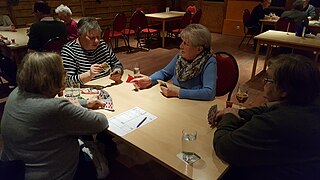
Fipsen or Fips is an old north German card game for 4 or 5 players that resembles British Nap in some respects. It is a trick-taking game played with a standard Skat pack that was once popular across North Germany in the former states of Schleswig, Holstein, Mecklenburg and Pomerania, but is now restricted to the south Holstein region. In the village of Thedinghausen in Lower Saxony, a rather different game is played under the same name for currant buns called Hedewigs. It has been described as "quite a special card game" that is "ancient, but very easy to learn".
The Crew: The Quest for Planet Nine is a board game for 3–5 players designed by Thomas Sing and released in 2019. In The Crew, a trick-taking cooperative card game with 50 missions, players aim to win tricks based on their task cards, but can only communicate limited information on their cards. Upon its release, The Crew received critical success and won numerous awards. A sequel, The Crew: Mission Deep Sea, was released in 2021.
Goldrausch is a card game published in 1990 by Hans im Glück. It is one of the first published games by prolific game designer Reiner Knizia, the rules, using two decks of regular playing cards, were first published in his book New Tactical Games With Dice and Cards.

German Tarok, sometimes known as Sansprendre or simply Tarok, is an historical ace–ten card game for three players that emerged in the 18th century and is the progenitor of a family of games still played today in Europe and North America. It became very popular in Bavaria and Swabia during the 19th century before being largely superseded by Schafkopf, but has survived in the local forms of Bavarian Tarock and Tapp. During the mid-19th century, it became the most popular card game among Munich's middle classes and was also played in the late 19th and early 20th centuries by notable Bavarian author Ludwig Thoma, frequently appearing in his novels and journal articles. It was superseded after the First World War by other forms such as Bavarian Tarock.
Cockroach Poker is a bluffing card game designed by Jacques Zeimet and published in 2004 by Drei Magier Spiele. Players pass around cards and try to avoid getting too many of the same type by deceiving other players about the cards's identities. The game was the first in Drei Magier Speile's Ugly Animals card game series. In 2012, the spin-off Cockroach Poker Royal was released.














